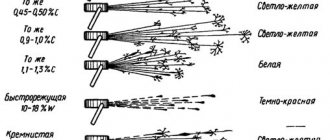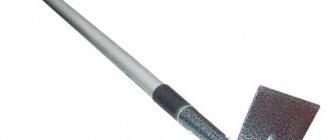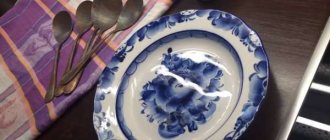You can protect yourself from buying cheap fakes by purchasing gold items exclusively from trusted jewelry stores that are ready to provide all the necessary certificates for the products, but even in this case there is a small chance of deception from unscrupulous sellers. The best option for checking the authenticity of jewelry is to order a paid examination from a jewelry workshop that is not interested in falsifying the results; however, knowing the basic physical and chemical characteristics of the materials, you can determine the material from which the product is made at home, without resorting to the services of specialists.
Properties of brass and its difference from gold. How brass is disguised as a noble metal
At a quick glance at gold and brass products, it may seem that they are made of the same metal. In fact, upon closer inspection, the difference between the materials will be visible. To do this, you need to pay attention to the main parameters, find out the composition, density, etc. Brass is an alloy of copper with zinc and several alloying components. Zinc is considered essential. The metal comes in two types: two-component and multi-component. Its physical and chemical characteristics:
- density - 8.5-8.7 kg/cm3;
- the metal is not ferromagnetic (but there are exceptions when a ferromagnetic substance is added to the composition during production);
- temperature at which the metal melts: 880-950°C;
- color - yellow with a golden tint;
- high degree of plasticity;
- untreated metal oxidizes upon contact with oxygen;
- corrosion resistance.
Brass exhibits different properties, which are determined by the content of alloying components. The type of products made from such metal depends on this. The main type of raw material for brass production is copper. In terms of strength, such a metal is inferior to many: bronze, but not gold (the latter is softer).
Due to its properties, brass is used in the manufacture of decorative items.
Two rings made of brass
When compared with gold, many differences are noted. But you can only learn about them by taking a closer look at the characteristics. Differences of gold:
- higher temperature at which the metal melts and density;
- bright shine: in comparison, brass also shines, often subdued, but this characteristic manifests itself in different ways, depending on the composition.
There are quite a lot of similar properties between metals, which explains the high risk of buying a fake, since brass can easily be disguised as gold; tricks are used for this:
- a certain number of components are used in production, thanks to them the finished product acquires external characteristics that make brass look like a noble metal;
- applying a decorative coating, for which the gilding technique is used; the brass is first polished.
Methods of applying gold plating
Among the possible options for applying gilding, experts distinguish two methods: mechanical and electrochemical. The mechanical method involves covering the surface with gold leaf. Gilding with the thinnest sheets of metal has been used since ancient times; over many centuries, the essence of the procedure has remained virtually unchanged. Gold leaf plating can be oil-based or glue-based; in the first case, the metal is glued to oil varnish, and in the second, to polyment. The oil-based coating turns out matte; to achieve the effect of a shiny surface, experts resort to using an adhesive base. Work on creating an adhesive coating can be carried out exclusively indoors, since such gilding is characterized by high sensitivity to moisture.
The electrochemical version of surface treatment with precious metal is a galvanic method of applying gold to a product. What it is? During the work, the master applies, using electric current, a thin layer of yellow precious metal, the size of which can reach fractions of microns.
Like any coating, electroplating has its advantages and disadvantages over other options. There are quite a few advantages of coating obtained in this way. These include a high level of wear resistance, excellent reflectivity, high current conductivity, the ability to protect the product from aggressive external factors, the effects of corrosive and oxidative processes. When applying galvanic coating, the specialist carrying out the work can control the thickness of the precious metal layer. Due to the listed properties, galvanic gilding is widely used both in surface decoration and for creating technical parts of devices.
Electrochemical deposition of gold on the surface.
For a long time, the main disadvantage of the method was considered to be the limited scope of its application. The electrochemical method of applying gold to a surface assumes that this surface is conductive, that is, made of metal. Thanks to scientific advances, this problem has now been partially resolved: special technologies make it possible to gild dielectric materials using conductive varnishes and films.
TOP 10 ways to distinguish gold from brass at home
They consider different possibilities to determine what metal an object is made of:
- perform an inspection: check the external characteristics (evaluate the appearance of the product, sound upon impact, etc.);
- they use methods to determine that it is brass or gold that is being considered;
- They use available means to ensure that the choice is correct.
Brass and gold ring
Ways to check brass jewelry by eye and sound
Before purchasing, it is not always possible to test with chemicals or use another method to determine the authenticity of a gold product. In this case, you should rely on indirect signs and some characteristics that are characteristic of the precious metal.
Availability of stamp and sample
Different types of equipment are used to mark jewelry:
- hallmark: placed on the product, confirms that the metal belongs to one group or another (common options for gold: 583, 585, 750), the shape is always rectangular;
- name book - contains information about the manufacturer;
- jeweler's mark or manufacturer's logo imprint.
If you need to determine how to distinguish gold from brass, you should learn how assaying is performed. This type of mark is placed on certain areas of products:
- rings - inner surface;
- earrings - clasp or stem (stud earrings);
- bracelets, like earrings, are punched from the inside;
- decorations with an English lock - on one of the elements of the locking mechanism;
- the clock is inside, on the lid.
In addition, the precious metal is hallmarked in a special way: the mark is clear, of the correct shape, and the numbers are clearly visible. Fakes often lack these signs.
In this case, the test is performed carelessly.
Sample on a gold ring
Cost of decoration
If the seller provided a real product and an appropriate price, then you can notice a huge difference between jewelry made of precious and non-precious metal. If the external signs are the same, you can focus on the cost. If the seller tries to pass off brass items as precious, setting the same price with identical characteristics of both types of jewelry, the buyer has little chance of purchasing a quality item. It is necessary to pay attention to indirect factors.
Throw decoration on glass
When dropped onto a glass surface or into a glass, a gold ring or earring makes a unique sound. It can only be compared to the sound of crystal. Brass will sound different due to the properties of the components, structure, and density of the material. You can conduct a small experiment - throw a brass object onto a glass display case. This action should be given the appearance of an accident so as not to arouse suspicion among store personnel. By the sound you can determine which metal the ring/earring belongs to.
Important! The method of determining the quality of jewelry by sound is only suitable for small items.
Dental check
The method was often used earlier, when the gold content in products was higher. As a result, softer products were produced. They were tested “to the teeth”, and characteristic traces remained. Today, jewelry is distinguished by higher hardness. This is due to the introduction of various alloying components into the composition. Accordingly, it is, of course, possible to try objects made of precious metals, but there is no guarantee that this method will give results.
For this reason it is used as an auxiliary measure.
Gold chloride reaction test
In everyday life, you can use a special product - gold chloride. But a small bottle is quite expensive. This means that it is advisable to purchase this product if you often have to deal with precious metals.
Special product - gold chloride
When the substance is applied to brass, the components react, which leads to a change in the appearance of the product. However, the precious metal behaves differently. If you apply gold chloride to such jewelry, there will be no changes in the appearance and properties of the item.
Product shades
From the hue you can only get a vague idea of the properties of the metal, since the color of gold is always different: it changes from light yellow to rich, almost red. It depends on the composition - the type of components. But still, there is always a bright shine on gold products. It does not always appear on brass jewelry. The combination of these two factors allows us to assess the quality of the item during external inspection.
Radical testing methods at home
If you are not sure whether the purchased product is truly gold, it is suggested that you consider more complex technologies. But not all of them are safe for the product being tested; there is a risk of damaging the item. In addition, they are used primarily in production areas and laboratories. There are no necessary equipment at home.
To distinguish between brass and gold, methods of remelting, exposure to aggressive environments, etc. are considered.
Crucible method
Containers are used for melting metal products. They are used for the purposes of combustion, weighing, homogenization, among others. Crucibles come in a variety of shapes and are made of refractory materials. Such containers are an integral part of laboratory equipment.
Crucible melting produces liquid metal, which is used to make other items.
In this case, the determining factors are the physicochemical properties of the material, in particular, the temperature at which the metal melts. This parameter determines the type of product: for gold this indicator is higher than for brass.
Crucibles for melting gold
Needle trick
The method is used to determine the sample of metal: it is necessary to draw stripes with needles of different samples (2 samples are enough), and a touchstone is placed between them. Acid is then applied to these areas. They are carried out with pass-through paper, which helps to change the color of the materials. In this way, the sample belongs to one of the metals.
If the item is fake (made of brass), then there will be no result or it will be significantly different from the expected one, which will confirm the assumption of a fake.
There is another method based on the use of a needle. It is used for small gold. Lines are drawn on the touchstone using samples. They will be of different colors: pale, brighter. This depends on the properties of the particles of gold or other metal left by the samples. By appearance, they determine whether the product belongs to a particular type of metal. This method makes it possible to find out the approximate content of alloying components, since the color of the finished item depends on the composition.
Nitric acid
A drop of nitric acid is applied to different products. If the metal does not change appearance upon contact, we can say that it is gold. Brass takes on a green tint when acid is applied.
Nitric acid (HNO3)
Tools at hand for testing
Simpler methods are also used to verify the authenticity of jewelry, but they can only act as auxiliary ones. The reason is the use of improvised means that act as reagents and catalysts.
Ceramic tile
It is necessary to find a sample of unglazed facing material. The secret is that when a gold piece is passed over ceramics without additives, it will leave a stripe of the same color as the metal.
Experiment with foundation
The method is based on the reaction of a cosmetic product with gold. You must first apply foundation to your skin. Then a product that raises doubts is passed over this area. Gold leaves a gray streak under these conditions. Brass leaves no marks.
Iodine test
When liquid products are used, it sometimes takes some time for the reaction to develop. But in the end, you can verify the authenticity of the purchased jewelry or, conversely, think about its quality: gold turns brown after contact with iodine, the external properties of brass will not change.
Iodine test
Vinegar test
Instructions:
- Prepare a container from a neutral material: ceramics, plastic.
- Add vinegar, then observe the reaction. Gold will not interact with this substance, stains will not appear on the product, and the general characteristics will be preserved. In comparison, brass can darken.
Black bread
Gold is not subject to oxidation (in its pure form), but modern metal most often contains a significant proportion of alloying components, so there is no 100% guarantee of the reliability of this method. But you can study the theory: if you put gold jewelry in bread pulp, it will retain its original color, but brass, on the contrary, can be seriously damaged (dark spots will appear).
lapis pencil
The product is sold at the pharmacy. It serves as a catalyst for reactions with components in metals. If you run it over a pre-moistened gold chain, nothing will happen; this metal will retain its original appearance.
Lapis pencil for testing gold
Magnetic reaction
The method is based on comparing products according to their magnetic properties. Brass is most often not ferromagnetic, but it can acquire the desired properties if a component with characteristic properties is introduced into the composition.
Gold does not react at all to an external magnetic field.
Sunbathing
Pay attention to the properties of metals under certain conditions. One way is to expose brass and gold to sunlight. In the first case, the intensity of the shine will be different - in the shade the metal is less bright than in the sun.
Gold, on the other hand, performs the same regardless of environmental conditions.
Archimedes' Law
The weight of metal products is taken into account. For example, gold is much heavier than brass. If you immerse a product in water, then, according to Archimedes’ law, a force equal to the weight of the water that was displaced will act on the body immersed in the liquid. When such an experiment is carried out, it will be found that gold sinks due to its weight, but brass does not. It is possible to independently perform simple calculations and determine the mass of the product.
Imitation gold
A variety of alloys are used for fake gold jewelry.
Aluminum bronze, which resembles gold in color. This alloy consists of 90% copper and 10% aluminum.
Aluminum bronze coin.
Belgica is an alloy similar to platinum. It contains about 74% iron, approximately 16% chromium, and almost 9% nickel.
Mosaic gold, which includes almost 70% copper and 30% zinc. Gives a hint of native gold.
Product made from tombak.
Tompak - this alloy is very similar to real gold. It is often brought by tourists from Turkey, Israel or China. If you don’t know how to distinguish gold, it’s better not to buy it in these countries.
There are a huge number of such alloys. Thanks to such materials, they learned to imitate real gold. Most often it is transported through smuggling. Counterfeiting gold is a very common phenomenon. Try not to fall into the “trap”.
Useful uses of brass in electronics
Brass is not a noble metal, but is a sought-after alloy. Parts of various mechanisms are made from it. Products made from brass:
- pipes for appliances;
- foil;
- sheets;
- bushings;
- wire;
- rods;
- tape, etc.
Brass is used in the installation of radio components, and is also used in radio instrument making (hardware, gears, and printed circuits are made). Moreover, the material is sent for re-melting, after which it can be reused.
Use of brass alloys in electronics
Jeweler's recommendations on how not to buy a fake
Molokanov N.M.
Jeweler, 26 years of experience in jewelry production.
Ask a Question
First of all, you should pay attention to the price. If it is low, then do not consider the purchase option. When the cost remains the same regardless of the composition of the material, you can inspect it and touch it. In most cases, the properties of the product are carefully studied. Brass is lighter than gold due to its low density.










